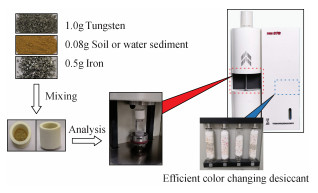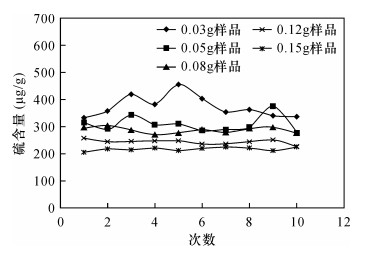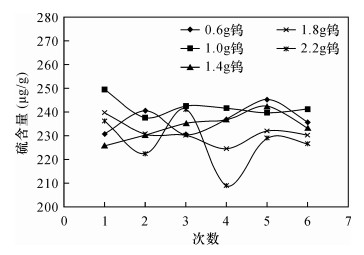Improvement of Experimental Conditions for the Determination of Sulfur in Soil and Stream Sediments by High-frequency Infrared Carbon and Sulfur Analyzer
-
摘要: 硫是多目标区域地球化学调查项目中的必测元素。应用高频红外碳硫仪测定样品过程中,由于坩埚空白、管路中水蒸汽、样品称样量、样品和助熔剂叠放顺序、助熔剂添加量等因素影响,导致硫测试值的重复性和准确度差,甚至为负数。本文研究了以上因素对硫测试值重复性和准确度的具体影响以及解决措施,着重对样品称样量、样品和助熔剂叠放顺序、助熔剂添加量进行对比实验,优化出适合分析土壤和水系沉积物中硫含量的最佳条件。结果表明:在降低坩埚空白,严格控制仪器气管中湿度的情况下,采用0.08g样品、0.5g铁和1.0g钨三者混合燃烧的方式分析样品后,其校准曲线线性良好(r ≥ 0.9990)。对不同分析结果采用分段做校准曲线校准,结果对数差△lg为-0.036~0.062,RSD为7.13%~9.93%,两者均符合《多目标区域地球化学调查规范(1:2500000)》(DZ/T 0258-2014)中要求,说明本方法分析结果准确度高、重复性良好。要点
(1) 分析了影响高频红外碳硫仪测定硫准确度的各个因素。
(2) 对比称样量、样品与助熔剂叠放顺序、助熔剂添加量三者不同条件下硫的测定结果。
(3) 优化出测定土壤和水系沉积物中硫的最佳分析条件。
HIGHLIGHTS(1) The various factors affecting the accuracy of sulfur determination by High-frequency Infrared Carbon-Sulfur Analyzer are investigated.
(2) The sulfur contents based on different sample weights, different stacking schedules of samples and fluxes, and different addition levels of flux are compared.
(3) The conditions for analyzing sulfur in soil and water sediments are optimized.
Abstract:BACKGROUNDIn the multi-target regional geochemi-cal survey project, sulfur is one of the analyzed elements. During measurement of samples with a high-frequency infrared carbon-sulfur analyzer, different factors include the blank of the crucible, water vapor in the pipeline, different sample weights, sample and flux stacking order, and different flux additions, which would result in poor reproducibility of sulfur and even a negative value.OBJECTIVESTo eliminate factors that affect the repeatability of sulfur analysis and improve the accuracy of sulfur analysis.METHODSThe conditions for determination of sulfur in soil-stream sediments were optimized by comparing the sample weight, sample and flux stacking order, and flux amount.RESULTSIn the case of reducing the blank value of the crucible and strictly controlling the humidity in the trachea of the instrument, the calibration curve shows a good relationship (r ≥ 0.9990) after the sample was analyzed by mixing 0.08g sample, 0.5g iron and 1.0g tungsten. After analyzing the different results using a calibration curve of the appropriate concentration, the logarithmic differences of the sulfur analysis results are -0.036-0.062 and the relative standard deviations (RSDs) are 7.13%-9.93%.CONCLUSIONSBoth the logarithmic difference and the standard deviation meet the requirement of multi-target regional geochemical survey (1:2500000), indicating that the analytical results of this method are accurate and reproducible.
-
Keywords:
- soil /
- stream sediment /
- sulfur reproducibility /
- iron and tungsten flux /
- optimal conditions
-
石榴石是地质体中一种常见的矿物,其主要化学元素少,晶体结构相对简单,但其类质同象非常复杂,这与其形成时的地质环境有直接关系。其中,镁铝榴石主要产在超基性岩中。我国江苏东海地区的镁铝榴石呈斑晶产于蛇纹石化超基性岩体中,如镁铝榴石含有足够铁铝榴石分子,当只有Fe起致色作用时,则呈现一种漂亮的淡紫-红。钙铝榴石仅产于钙质矽卡岩中,是矽卡岩及有关矿床中的其中一种标型造岩矿物,主要产于东非的肯尼亚、坦桑尼亚和马达加斯加,我国安徽铜山、湖南柿竹园、西藏冈底斯等地均有产出;同时钙铝榴石也作为软玉中的次要矿物出现,在玛纳斯、台湾、加拿大等地出产的碧玉中常见,但在其他品种的软玉中极少见[1-6]。钙铝榴石因含Cr3+、V3+类质同象替代Al3+时而呈现绿色。锰铝榴石是泥质岩层经低级区域变质作用的产物,主要限于绿片岩相中。锰铝榴石有橙色、褐橙色和橙红色,其橙色是由于含有致色元素Mn。铁铝榴石和锰铝榴石产于伟晶岩中。如美国加利福尼亚州拉莫地区锂云母型伟晶岩中的锰铝榴石。类似情况还见于马达加斯加、印度等[3-6]。
石榴石属等轴晶系岛状硅酸盐矿物,晶体结构中岛状分布的硅氧四面体之间由以三价阳离子为中心的八面体及以二价阳离子为中心的十二面体相互连接。这一族矿物存在着广泛的类质同象替代,在矿物学中,根据进入晶格离子的类型,将石榴石的类质同象替换分为两大系列:铝质系列和钙质系列。铝质系列,常见品种有镁铝榴石、铁铝榴石、锰铝榴石;钙质系列,常见品种有钙铝榴石、钙铁榴石、钙铬榴石[2-3]。铝质系列和钙质系列矿物组成了石榴石族,其间有类质同象产生的过渡型矿物[6-7]。在实际情形中,石榴石不是纯的端元组分,常常含有两种或以上端元组分。此外,一些石榴石晶格中还附加有OH-离子,形成含水的亚种,如水钙铝榴石[8-9]。类质同象的普遍替代,使得石榴石颜色非常丰富,而在研究石榴石的种属时,常规手段存在很强的局限性,一方面是因为不同石榴石品种在矿物学和谱学数值上重叠很多,另一方面是因为研究测试手段本身的局限性。例如,用X射线荧光光谱法对石榴石进行研究,仅能给出半定量分析,必须结合其他手段予以定名[10]。另外,以往大多数矿物学研究采用常规的电子探针等微区微量测试手段,分析矿物主量元素差异[11],但是石榴石类质同象复杂,除主量元素外,微量元素含量变化亦很大,要借助微量元素分析手段,如电感耦合等离子体质谱法等,对石榴石进行全岩微量元素测试。随着研究手段的发展,多种光谱学分析方法被广泛应用于矿物学研究,以补充单纯成分研究的不足[12-15]。例如,利用拉曼光谱特征峰的偏移研究石榴石的类质同象替换产生现象[16-18];利用红外吸收光谱特征确定石榴石种属[19];利用紫外可见吸收光谱确定石榴石中特征致色离子[20]。但是前人关于石榴石的研究,多局限于个别测试手段的应用,难以获取全面系统的分析数据,不能就常见不同品种石榴石的成分和结构变异特征给出可靠的矿物学研究结论。
基于以上分析,本次工作借助多种仪器测试手段和全面的谱学分析方法,对目前常见的石榴石品种进行综合系统的研究。本文以红色、橙色、绿色和褐红色不同颜色种类的石榴石品种为研究对象,通过电子探针、电感耦合等离子体质谱(ICP-MS)、X射线粉晶衍射(XRD)、拉曼光谱、傅里叶变换红外光谱(FTIR)和紫外可见吸收光谱等测试方法,对样品的化学成分、晶体结构与谱学特征进行全面系统的对比分析,以期为不同地质体中产出的石榴子石的矿物学特征总结及地质应用提供依据。
1. 实验部分
1.1 样品来源和研究目的
实验部分测试样品取自志东公司收藏的4块石榴石样品,分别编号为G1、G2、G3和G4,其中G1为红色,G2为橙色,G3为绿色,G4为褐红色。本次研究工作目的是了解不同颜色石榴石的成分、晶体结构、物理特征并准确予以定名。通过样品系统测试和分析,揭示石榴石成分变异对晶体结构、光谱特征影响和制约关系。
1.2 样品分析方法
样品主量元素分析:在中国地质科学院矿产资源研究所完成。测试仪器为JXA 8230型电子探针。硅酸盐和氧化物在电压15kV的操作环境下进行,电流20mA,波长5μm。
样品微量元素分析:在国家地质实验测试中心完成。测试仪器为NexION 300D型电感耦合等离子体质谱仪(美国PerkinElmer公司),含量高于10μg/g的元素的相对误差小于5%,含量小于10μg/g的元素的相对误差小于10%。
X射线粉晶衍射(XRD)晶体结构测试:在中国科学院理化技术研究所完成。测试仪器为D8 Focus型多晶X射线衍射仪(德国Bruker公司)。实验条件为:X射线发生器功率2.2kW;铜靶陶瓷X光管;扫描方式θ/2θ测角仪;扫描范围20°~89°;测角精度0.0001°。目的在于确定不同颜色石榴石的晶体结构及为其定名。
拉曼光谱测试:在中国科学院理化技术研究所完成。测试仪器为inVia-Reflex型显微共聚焦激光拉曼光谱仪(英国Renishaw公司)。实验条件为:激发波长532nm;测试范围100~1400cm-1;激光强度10%;扫描时间30s;叠加次数3次。目的是分析拉曼光谱特征峰的偏移来确定石榴石的类质同象替换情况。
红外光谱测试:在中国科学院理化技术研究所完成。测试仪器为Excalibur 3100型傅立叶变换红外光谱仪(原美国Varian公司)。实验条件为:测试范围400~1200cm-1;分辨率0.20cm-1;叠加次数64次。目的是根据红外谱带的频率和强度的变化,对石榴石矿物品种进行鉴定。
紫外可见吸收光谱测试:在中国科学院理化技术研究所完成。测试仪器为Cary 5000型紫外可见近红外分光光度计(原美国Varian公司)。实验条件为:测试范围1100~200nm,分辨率为0.5nm,扫描速度为2.64nm/s。目的是根据特征离子价电子的跃迁产生的吸收性质,确定石榴石中特征致色离子。
2. 结果与讨论
2.1 主量元素特征
实验中分别对4种石榴石样品进行电子探针测试,其主量元素测试结果见表 1。由于电子探针无法对铁元素的价态进行测定,样品中的全铁含量采用二价离子进行计算。石榴石的通用化学式为X3Y2(SiO4) 3。在铝质系列中,Y以三价阳离子Al3+为主,X为半径较小的二价阳离子,如Mg2+、Fe2+和Mn2+等,这样铝质系列中的常见品种有镁铝榴石、铁铝榴石、锰铝榴石等。在钙质系列中,X以大半径的二价阳离子Ca为主,Y为三价阳离子,如Al3+、Fe3+、Cr3+等,这样钙质系列中的常见品种有钙铝榴石、钙铁榴石、钙铬榴石等[13]。
表 1 石榴子石样品中的主量元素电子探针分析结果Table 1. EMPA results of major elements in garnet samples样品编号 含量(%) SiO2 TiO2 Al2O3 Cr2O3 FeO MnO MgO CaO 8种氧化物之和 Si Ti Al Cr Fe3+ Fe2+ Mn Mg Ca Uvt And Py Sps Grs Alm G1 37.65 0 21.34 0 19.87 4.12 16.13 1.33 100.44 2.82 0 1.88 0 0.24 1.01 0.26 1.8 0.11 0 11.1 56.66 8.22 0 31.76 G2 35.67 0.06 19.99 0 0.84 39.39 2.23 0.75 98.93 2.95 0 1.95 0 0.06 0 2.76 0.28 0.07 0 2.81 8.87 88.99 0 0 G3 36.60 0.40 20.74 0.17 0.06 5.98 0.55 34.81 99.31 2.85 0.02 1.91 0.01 0 0 0.40 0.06 2.91 0.47 0.17 1.9 11.37 85.73 0 G4 37.61 0.06 21.34 0 18.03 4.52 15.87 3.04 100.47 2.81 0 1.88 0 0.24 0.89 0.29 1.77 0.24 0 11.41 55.56 8.99 0 27.8 注:以12个氧原子和8个阳离子为计算基础。Uvt—钙铬榴石; And—红柱石; Py—黄铁矿; Sps—锰铝榴石; Grs—钙铝榴石。 此外,一些石榴石的晶格中还附加有OH-离子,形成含水的种。根据表 1中化学百分含量及石榴石中离子占位及价态分布,将Fe元素进行重新分配,得到石榴石样品的晶体化学式。样品G1(Mn0.261Ca0.107,Fe1.0102+,Mg1.802)Σ=3.18 (Fe0.2353+Al1.884)Σ=2.119 Si2.821 O12 ,以镁铝榴石成分为主(56.66%),其中存在一定的Mn2+、Fe2+和Ca2+代替Mg2+。样品G2(Mn2.755Ca0.066Mg0.275)Σ=3.116 (Fe0.0583+Al1.946)Σ=2.004 Si2.946 O12 ,以锰铝榴石成分为主(88.99%),其中存在一定的Ca2+和Mg2+代替Mn2+。样品G3(Mn0.395Ca2.908Mg0.064)Σ=3.367 (Fe0.0043+Al1.906)Σ=1.91 Si2.853 O12,以钙铝榴石成分为主(85.73%),其中畸变的配位立方体中存在一定的Mn2+、Mg2+代替Ca2+。样品G4(Mg1.769)Σ=3.184 (Fe0.2423+Al1.881)Σ=2.123 Si2.812 O12以镁铝榴石成分为主(55.56%),其中存在一定的Mn2+、Fe2+和Ca2+代替Mg2+。据文献报道[16-17, 21-22],石榴石成分发生变化的主要原因是石榴石形成时的温度、压力条件,特别是形成时的压力不同而导致成分在空间上发生规律性变化,其成分的变化主要是二价阳离子的变化所致。石榴石晶格处于八面体配位的不同的二价阳离子半径有差异。在高压下,小配位半径的阳离子(Mg2+、Fe2+)比大配位半径的阳离子(Ca2+、Mn2+)易进入晶格,形成稳定的八次配位,而在低压下大配位半径阳离子进入晶格八次配位时的稳定性远远大于小配位半径阳离子的稳定性。由于Ca2+、Mn2+、Fe2+、Mg2+的配位半径依次递减,它们进入晶格所需的压力条件不同。配位半径大的离子,进入晶格时压力条件要小些,因此随着压力的增加,Ca2+含量降低,即石榴石中钙铝榴石的摩尔分数降低。Mn2+进入晶格时所需的压力较小,Mg2+需要很大的压力条件才能在晶体中呈现稳定的八次配位,而Fe2+介于两者之间。所以,可以推测,4件样品形成的压力条件是:G3(钙铝榴石) < G2(锰铝榴石) < G1、G4(镁铝榴石)。此外,根据不同样品间主要成分中特征元素制作差异对比图可知,G1和G4(镁铝榴石)样品中含有大量Fe,推测这是样品呈现红色调的主要原因。而G2(锰铝榴石)呈现明亮橙色,推测这与样品中含有大量锰元素有关。但是,该结论需要后续实验进行补充验证。
2.2 微量元素特征
通过对上述石榴石样品中主量元素的研究,得出了4件样品的种属分类,并分析了样品中存在的主要类质同象替换离子种类。但是,同种石榴石的颜色差异,常常是由微量元素引起的。为了进一步明确颜色与成分的差异,对4种石榴石样品进行ICP-MS测试,微量元素测试结果列于表 2。可以看到,相对于其他三个样品,G3(钙铝榴石)中含有较多Cr和V,推测这是该样品呈现绿色的主要原因,后续光谱学研究将进一步对此结论进行验证分析。此外,4件石榴石样品中都含有较大量Zn元素,虽然不同样品中的含量有差异,但是总体而言,Zn元素的含量偏高,这表明锌离子的类质同象替换普遍存在。本次测试的4件样品中其他微量元素含量均较低,无显著差异性。
表 2 石榴石样品中的微量元素和稀土元素组成Table 2. Trace elements and rare earth elements composition of garnet samples微量元素 含量(×10-6) G1 G2 G3 G4 Cr 233 60.9 3453 126 V 132 1.42 1358 30.3 Zn 3447 1851 2188 3116 Ni 1.21 2.09 < 0.05 3.3 Rb 0.18 0.38 0.25 0.21 Sr 3.60 1.93 3.83 1.59 Ba 4.31 6.39 3.55 1.66 Pb 2.92 0.85 1.68 0.84 Nb 12.6 19.8 13.8 1.43 Ta 0.31 0.35 0.15 0.32 Zr 18.7 10.3 43.9 88.9 Hf 1.21 1.01 2.1 2.55 Be < 0.05 0.59 1.03 0.07 Sc 282 5.67 11.8 118 Cu 2.49 4.25 2.22 2.18 Ga 7.93 51.7 77.8 5.51 Mo 0.42 0.13 0.52 0.29 Cd 0.90 0.56 0.18 0.24 Cs 0.05 0.16 0.2 0.06 W 1.02 0.45 0.39 0.85 La 0.39 0.42 0.2 6.58 Ce 0.26 0.85 0.2 7.07 Pr 41.5 1.23 4.9 101 Nd 1.03 0.63 0.9 8.93 Sm 12.7 7.59 5.9 32.6 Eu 4.76 21.9 12 47.8 Gd 52.9 52.5 18 108 Tb 123 130 26 187 Dy 181 171 30 232 Ho 191 169 28 235 Er 205 181 32 269 Tm 196 175 33 271 Yb 189 169 36 269 Lu 174 161 36 243 Y 202 190 33 276 REE 1574 1433 296 2293 LREE/ HREE 0.04 0.02 0.1 0.1 Eu/Eu* 0.15 0.73 1 0.68 Ce/Ce* 0.01 1.04 0.1 0.13 注:Eu/Eu*=2EuN/(SmN+GdN),无单位;Ce/Ce*=2CeN/(LaN+PrN),无单位;LREE/HREE无单位。 2.3 稀土元素特征
对4种石榴石样品进行ICP-MS测试,同时获得样品的稀土元素含量信息,测试结果见表 2,稀土元素配分曲线见图 1。4件样品的稀土元素呈现HREE富集的左倾曲线。稀土元素总量变化范围较大,ΣLREE为296×10-6~2293×10-6,Y含量分布不均,为33×10-6~276×10-6,LREE/HREE比值小于1,表现为重稀土元素富集,Eu/Eu*比值小于1,为Eu负异常。所有样品的Ce异常均不明显,为弱或不明显的亏损,稀土元素进入石榴石的方式主要为受晶体化学控制的类质同象替换[16]。前人研究显示,HREE较LREE更容易进入石榴石的晶格内部,因而当稀土元素在石榴石中的分配受其晶体化学结构制约时,石榴石应呈HREE富集、LREE亏损的分配特征。稀土元素在石榴石与熔体或流体之间的分配系数无论是在铝质榴石系列中还是在钙质榴石系列中都是∑HREE>∑LREE[23-24]。此外,石榴子石的八面体位置适合半径较小的HREE进入而不能容纳半径较大的LREE[25]。因此,通常情况下石榴石应具有HREE富集的左倾斜型配分模式。岩浆成因及变质成因的富铝石榴子石(钙铝榴石、镁铝榴石、铁铝榴石以及锰铝榴石)多具有HREE富集、LREE亏损的特征,指示岩浆及区域变质环境下稀土元素在富铝石榴石中的分配主要受到石榴石的晶体化学结构所影响[26-27]。
2.4 X射线粉晶衍射分析结果
为了研究4种石榴石样品的晶体结构特征和差异,对样品进行X射线粉晶衍射(XRD)晶体结构测试(图 2),并由此给出石榴石样品的定名。4种颜色石榴石分别为G1:镁铝榴石(Pyrope),G2:锰铝榴石(Spessartine),G3:钙铝榴石(Grossular),G4:镁铝榴石(Pyrope)。这个结论与上述成分分析结果一致。此外,4件石榴石样品的晶胞参数,分别是a=11.530nm (G1)、11.563nm(G2)、11.849nm(G3)和11.470nm(G4),其中钙铝榴石>锰铝榴石>镁铝榴石。这表明类质同象替换对石榴石晶体结构产生影响,随着不同种类离子替换石榴石晶格中的A和B位,石榴石的晶胞参数出现明显差异。综上,XRD定名结果与成分分析结果对应,验证了石榴石样品定名的准确性,同时石榴石中随着离子替换的发生,晶格发生变化。
2.5 红外光谱特征
石榴石的红外光谱图中,位于指纹区的红外谱带的频率和强度与成分关系密切,可以对石榴石矿物品种进行鉴定(图 3)。由于石榴石中普遍存在的类质同象替换,红外光谱与上述其他研究手段结合,能更好地指示石榴石的鉴定和特征分析[28-29]。
石榴石中各振动模形式以不可约可以表示为:Γ=3A1g +5A2g+8Eg+14F1g +14F2g +5A1u +5A2u +10Eu +17F1u+16F2u[30]。其中,满足选择定律,且使分子偶极距发生变化的简正振动模式才能是红外活性的。理论上来说,石榴石中应出现17个红外光谱的基频谱线[31],而实际样品测试中不会出现完整的17个谱线。其中,一般而言,800~1100cm-1处会出现3个吸收带,是[SiO4]四面体伸缩振动(反对称伸缩振动)所致,实验中石榴石样品在该处红外光特征峰较弱,G2和G3观察到3个吸收带,而G1和G4仅出现两个吸收带。然后,在400~700cm-1处的3个吸收带是四面体弯曲振动(反对称弯曲振动)所致,而石榴石样品在此区域,G1和G2观察到3个吸收带,G3和G4仅出现两个吸收带。此外,500cm-1以下的吸收是石榴石中除了Si以外的阳离子的相关振动引起的:400~500cm-1与三价阳离子相关振动相关,因在石榴石晶格内八面体三价原子团比硅氧四面体有较大的体积,使得谱带以较小的波数出现在低频区域[21]。
此外,样品红外光谱中未显示水分子的信号,表明这4件石榴石样品不含水。本实验中,因实验所限,未获得更精确的红外数据,仅给出石榴石大类确定,无法对不同样品的种属划分提供确定性证据。本次实验所测4件样品指纹区的红外光谱基本一致,因离子替换的普遍存在,个别峰的峰强略有差异,而峰位偏移也有出现。但是,4件样品红外光谱的信息差异不明显。
2.6 拉曼光谱特征
为了进一步研究石榴石样品的谱学特征,以补充红外光谱分析的不足,对样品进行拉曼光谱测试(图 4)。在硅酸盐系列矿物的拉曼光谱中,硅氧Si—Onb的伸缩振动在800~1250cm-1,桥氧(Si—Obr—Si)的反伸缩加弯曲振动频率位于450~760cm-1;[SiO4]旋转振动R[SiO4]产生的拉曼位移一般小于400cm-1[32]。石榴石中各振动模式列于上述红外分析中,其中A1g、Eg、F2g为拉曼活性[16]。由于石榴石族矿物之间存在普遍的类质同象替换,因此不同品种石榴石的拉曼光谱的谱峰位置必将存在差异[13]。4件石榴石样品所测的拉曼光谱中重要峰均出现,但是存在明显差异。需要注意的是,G3因样品存在强荧光,出现明显拉曼信号抬高现象。其中,900cm-1附近拉曼峰归属于Si—Onb伸缩振动(A1g模),其两侧的两个小峰由Si—Onb伸缩振动Eg+F2g模引起,这3个拉曼位移是石榴石Si—Onb伸缩振动的特征峰。实验中出现400~700cm-1之间的4个拉曼位移峰由石榴石的桥氧(Si—Obr—Si)的反对称伸缩加弯曲振动引起。[SiO4]四面体的对称伸缩振动产生的拉曼峰位与晶胞面积有关。在不同端元组分石榴石中,随着晶格常数变大,拉曼位移朝着低频方向移动,在铝质系列和钙质系列中均有这种规律。在晶体结构测试部分所示,石榴石样品的晶胞参数:G3>G2>G1(G4),因此,相应样品的拉曼特征峰也出现对应的向波数小的方向偏移。
为了更清晰地分析石榴石样品的拉曼特征,在下文列出样品的拉曼光谱特征峰,结合前人文献中对纯净端元组分石榴石的拉曼光谱研究,对各种属石榴石的拉曼光谱进行粗略分类:镁铝榴石的拉曼特征峰在912cm-1、552cm-1、355cm-1附近;铁铝榴石在916cm-1、500cm-1、340cm-1附近;锰铝榴石在900cm-1、543cm-1、341cm-1附近;钙铝榴石系列在874cm-1、543cm-1、368cm-1附近;钙铁榴石在867cm-1、507cm-1、370cm-1附近。
实验中样品G1和G4对应镁铝榴石的特征拉曼峰,而样品G2的特征拉曼峰指示与锰铝榴石对应,样品G3则与钙铝榴石拉曼峰呈现很好的对应关系。这个结论与之前对样品进行的成分及结构分析结果一致,同时也表明拉曼光谱测试这种分析手段在石榴石种属确定中具备重要的参考价值。
2.7 紫外可见吸收光谱特征
分析不同颜色石榴石样品的紫外可见吸收光谱,能给出石榴石中特征离子价电子在电子能级间的跃迁而产生的吸收性质,从而确定石榴石中的特征致色离子,为石榴石种属鉴定提供完备的依据和补充。
图 5给出4件石榴石样品的紫外可见吸收光谱对比,4件样品的紫外吸收峰值位置有明显差异。由前面的成分和结构分析可知,石榴石中普遍存在类质同象替换,石榴石的吸收光谱由类质同象替代的铁、锰、铬离子等共同作用影响。
样品G1与G4均为镁铝榴石,光谱特征较一致。但是,样品G1中出现的570nm附近的吸收峰, 归属于Fe3+ 的电子跃迁[8],样品G4的该类特征峰不明显。样品G1和G4在690~700nm附近都出现了小的吸收峰,该峰归属于样品中含有的微量Cr。样品G2中大量含有Mn2+ ,Mn2+电子态为3d5,460nm和520nm附近吸收峰为Mn2+的d-d电子跃迁所致。样品G3中,590~665nm处出现强的吸收带,由Cr3+分裂的能级之间的跃迁产生,这也是样品呈现绿色的原因[1, 33]。
3. 结论
本次工作利用电子探针、电感耦合等离子体质谱、X射线粉晶衍射、拉曼光谱、红外光谱和紫外可见吸收光谱等测试方法,对石榴石样品进行了全面系统的矿物学研究,获得了石榴石矿物系统的结构和成分数据。研究结果表明,4种颜色的石榴石样品分属于铁铝榴石(红色和褐红色)、锰铝榴石(橙色)和钙铝榴石(绿色),电子探针和光谱分析均证实鉴定结果的准确性。4件样品的稀土元素均呈HREE富集的左倾配分模式,但稀土元素总量变化范围较大,LREE/HREE比值小于1,Eu负异常。石榴子石的八面体位置适合半径较小的HREE进入,岩浆成因及变质成因的富铝石榴石(钙铝榴石、镁铝榴石、铁铝榴石以及锰铝榴石)多具有HREE富集、LREE亏损的特征,稀土元素在富铝石榴石中的分配主要受到石榴石的晶体化学结构所影响,进入石榴石的方式主要为受晶体化学控制的类质同象替换;同时类质同象替换亦对石榴石晶体结构产生影响,随着不同种类离子替换石榴石晶格中的A和B位,石榴石的晶胞参数出现明显差异。4件石榴石样品拉曼峰位的变化也与晶胞面积密切相关,随着晶格常数变大,拉曼位移朝着低频方向移动,在铝质系列和钙质系列中均有这种规律。
通过比较不同样品中的主量元素和微量元素含量可知,样品G1和G4(镁铝榴石)中含有大量Fe,样品G2(锰铝榴石)中含有大量Mn;样品G3(钙铝榴石)中含有较多Cr和V。由此推测,特征的Fe、Mn、Cr和V含量分别是G1和G4显红色、G2显亮橙色、G3显绿色的主要致色原因。样品的拉曼光谱和紫外可见吸收光谱特征与样品成分分析结果较一致。石榴石的颜色与其成分和结构具有良好的对应关系。4件样品多数微量元素含量均较低,无显著差异性特征。而Zn元素的含量普遍偏高,这表明锌离子的类质同象替换普遍存在。由于本次实验条件所限,对样品Zn元素明显富集的原因有待于本课题组下一步研究深化。
-
表 1 铁添加量不同时硫分析结果
Table 1 Analytical results of sulfur with different iron weights
分析项目 铁添加量不同时硫分析结果 0.1g 0.3g 0.5g 0.7g 0.9g 硫含量6次测试值
(μg/g)241.67 238.84 268.21 241.60 276.68 244.85 231.42 242.96 272.56 278.72 220.69 242.04 276.05 276.76 277.17 235.55 261.10 274.65 253.90 246.73 261.13 258.62 249.55 293.70 262.72 271.12 258.08 265.75 286.39 256.52 最大值与最小值差值(μg/g) 29.450 22.260 33.090 52.100 31.990 平均值(μg/g) 245.84 248.35 262.86 270.82 266.42 认定值(μg/g) 254 254 254 254 254 标准偏差(μg/g) 18.05 12.49 13.59 19.72 13.20 表 2 土壤和水系沉积物标准物质中的硫分析结果
Table 2 Analytical results of sulfur in soil and stream sediment of certified reference materials standard materials
分析项目 GBW07448 GBW07453 GBW07456 GBW07308a GBW07360 GBW07362 硫含量10次测试值
(μg/g)775.42 2006 256.21 70.53 499.82 111.05 767.21 2012.2 273.76 69.93 500.1 121.70 769.22 2004.2 264.04 56.88 487.24 132.04 758.32 1986.4 278.64 63.29 476.86 132.55 770.51 2009.8 277.07 67.24 477.2 127.06 780.96 2010.8 267.28 55.92 483.68 133.44 777.98 2013.9 274.82 72.95 495.75 135.14 794.83 2002.0 261.36 76.97 501.79 125.61 767.44 2002.4 268.73 52.25 487.36 125.82 768.9 1991.4 272.52 56.23 487.69 124.20 硫含量测试平均值(μg/g) 773.08 2003.9 269.44 64.21 489.74 126.86 硫含量认定值(μg/g) 816 2000 254 66 532 110 对数差Δlg -0.023 0.001 0.026 -0.012 -0.036 0.062 相对标准偏差(%) 9.93 8.97 7.26 8.50 9.22 7.13 -
张长均, 王蓬, 张之果.影响高频红外碳硫仪分析结果稳定性因素的探讨[J].冶金分析, 2006, 26(6):90-91. doi: 10.3969/j.issn.1000-7571.2006.06.029 Zhang C J, Wang P, Zhang Z G.Discussion on the factors affecting the stability of high frequency infrared carbon and sulfur analyzer[J].Metallurgical Analysis, 2006, 26(6):90-91. doi: 10.3969/j.issn.1000-7571.2006.06.029
黄启华, 徐志强, 杨玮玮.高频红外碳硫仪测定重晶石和黄铁矿中的硫[J].岩矿测试, 2017, 36(2):130-135. doi: 10.15898/j.cnki.11-2131/td.2017.02.006 Huang Q H, Xu Z Q, Yang W W.Determination of sulfur in barite and pyrite by high infrared carbon-sulfur spectrometer[J].Rock and Mineral Analysis, 2017, 36(2):130-135. doi: 10.15898/j.cnki.11-2131/td.2017.02.006
施善林, 李东麟, 李晓晗.高频燃烧红外吸收法测定镍铁合金中硫含量[J].有色矿冶, 2015, 31(3):52-54. doi: 10.3969/j.issn.1007-967X.2015.03.016 Shi S L, Li D L, Li X H.Determination of sulfur in ferro-nickel alloy by high frequency-absorption method[J].Non-ferrous Mining and Metallurgy, 2015, 31(3):52-54. doi: 10.3969/j.issn.1007-967X.2015.03.016
刘志, 段英楠.红外碳硫分析仪测定土壤样品中的碳和硫[J].吉林地质, 2009, 28(3):103-105. doi: 10.3969/j.issn.1001-2427.2009.03.028 Liu Z, Duan Y N.Detrmination of carbon and sulfur in soil samples by high frequency IR absorption spectrometric method[J].Jilin Geology, 2009, 28(3):103-105. doi: 10.3969/j.issn.1001-2427.2009.03.028
史世云, 温宏利, 李冰, 等.高频燃烧-红外碳硫仪测定地质样品中的碳和硫[J].岩矿测试, 2001, 20(4):267-271. doi: 10.3969/j.issn.0254-5357.2001.04.006 Shi S Y, Wen H L, Li B, et al.Determination of carbon and sulfur in geological samples by high frequency IR-absorption method[J].Rock and Mineral Analysis, 2001, 20(4):267-271. doi: 10.3969/j.issn.0254-5357.2001.04.006
刘行周, 李永强, 霍立伟, 等.高频红外碳硫分析仪CS-8800检测铸铁中碳硫元素含量的方法研究[J].山东化工, 2014, 43(8):66-67. doi: 10.3969/j.issn.1008-021X.2014.08.022 Liu X Z, Li Y Q, Huo L W, et al.Study on the method of carbon sulfur content by high frequency infrared carbon sulfur analyzer CS-8800 detection in cast iron[J].Shandong Chemical Industry, 2014, 43(8):66-67. doi: 10.3969/j.issn.1008-021X.2014.08.022
龚仓, 付桂花, 黄艳波.高频燃烧-红外碳硫仪测定岩心钻探样品中碳硫[J].黄金, 2016, 37(12):77-80. doi: 10.11792/hj20161219 Gong C, Fu G H, Huang Y B.Determination of carbon and sulfur in drilling core samples by high frequency combustion-infrared carbon and sulfur analyzer[J].Gold, 2016, 37(12):77-80. doi: 10.11792/hj20161219
徐霞.高频红外碳硫分析仪测定铬铁矿中硫含量[J].化工时刊, 2016, 30(8):23-25. http://d.old.wanfangdata.com.cn/Periodical/hgsk201608008 Xu X.High frequency infrared carbon sulfur analyzer determination of sulfur content inchromite[J].Chemical Industry Times, 2016, 30(8):23-26. http://d.old.wanfangdata.com.cn/Periodical/hgsk201608008
王娜.高频红外碳硫分析仪测定石膏矿中的三氧化硫[J].分析测试技术与仪器, 2017, 23(2):120-123. http://d.old.wanfangdata.com.cn/Periodical/fxcsjsyyq201702009 Wang N.High frequency infrared carbon sulfur analyzer determinate sulfur trioxide in gypsummines[J].Analysis and Testing Technology and Instruments, 2017, 23(2):120-123. http://d.old.wanfangdata.com.cn/Periodical/fxcsjsyyq201702009
况芳城.高频红外碳硫分析仪测定地质样品中不同含量的硫[J].福建地质, 2013, 32(3):249-252. doi: 10.3969/j.issn.1001-3970.2013.03.011 Kuang F C.Determination of the different content of sulfur in geological samples by high frequency IR Carbon-sulfur analyzer[J].Geology of Fujian, 2013, 32(3):249-252. doi: 10.3969/j.issn.1001-3970.2013.03.011
张明杰, 戴雪峰, 陆丁荣, 等.高频燃烧-红外碳硫仪用于农用地土壤质量调查样品中碳硫的快速测定[J].岩矿测试, 2010, 29(2):139-142. doi: 10.3969/j.issn.0254-5357.2010.02.011 Zhang M J, Dai X F, Lu D R, et al.Rapid determination of carbon and sulfur in farmland soil samples by high frequency-infrared carbon sulfur analyzer[J].Rock and Mineral Analysis, 2010, 29(2):139-142. doi: 10.3969/j.issn.0254-5357.2010.02.011
-
期刊类型引用(6)
1. 陈星韵,张良,王豪帅,张瑞锐,孙思辰. 福建云霄石榴子石宝石矿物学特征. 岩石矿物学杂志. 2024(03): 673-684 .  百度学术
百度学术
2. 韩萧萧,梁涛,王思雨,熊竹楠,王凌青. 电感耦合等离子体质谱联用技术在稀土元素物源指示研究中的应用进展. 岩矿测试. 2023(01): 1-15 .  本站查看
本站查看
3. 毛金伟,冷成彪,赵严,李凯旋,陈涛亮,梁丰,高粉粉,张兴春. 云南中甸红牛-红山大型夕卡岩铜矿床石榴子石U-Pb年代学、元素地球化学及地质意义. 矿物岩石地球化学通报. 2023(06): 1329-1343+1-11 .  百度学术
百度学术
4. 胡靓,张德贤,娄威,胡子奇,刘金波. 含膏盐建造铁矿床中磁铁矿LA-ICP-MS微量元素测定与地球化学特征研究. 岩矿测试. 2022(04): 564-574 .  本站查看
本站查看
5. 王浩,杨岳衡,杨进辉. 矿物微区Lu-Hf同位素分析技术研究进展. 岩矿测试. 2022(06): 881-905 .  本站查看
本站查看
6. 朱丽,杨永琼,顾汉念,温汉捷,杜胜江,罗重光. 电感耦合等离子体质谱-X射线衍射法研究云南玉溪和美国内华达地区黏土型锂资源矿物学特征. 岩矿测试. 2021(04): 532-541 .  本站查看
本站查看
其他类型引用(5)



 下载:
下载:








 京公网安备 11010202008159号
京公网安备 11010202008159号